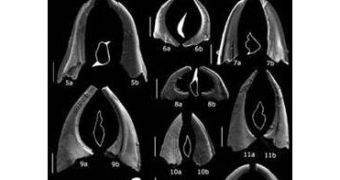For the first time in western Mediterranean, a team of Spanish scientists have found fossils of Ordovician conodonts that were dated to between 446 and 444 million years ago.
Discovering these prehistoric marine vertebrates (according to Clare Milsom and Sue Rigby), has allowed scientists to rebuild the paleogeography of the Cordillera Bética mountain range.
According to their study, the mountain system in the south of the Iberian Peninsula was located alongside the Alps at that time, AlphaGalileo reports.
The conodonts were small, eel-shaped animals without any vertebral column, and only measured a few tenths of a millimeter in length.
They lived in the oceans, during the Paleozoic era and at the end of the Triassic – some 205 million years ago, they became extinct.
The conodonts discovered until now, were rather pieces of under one millimeter in size, than complete fossilized bodies, with a phosphate composition very much like that of vertebrate teeth.
Researchers presume that they used these teeth to catch and grind up their food, and the geologists explain that “these teeth were the only mineralized pieces of conodonts, meaning they are generally the only remains to have fossilized, although complete conodont fossils have been found in other parts of the world.”
Four years ago, in 2006, a team of Andalusian geologists found the oldest fossils of the Cordillera Bética, in the Maláguide Complex in Ardales (Malaga), and concluded that they dated from the late Ordovician period, 446 to 444 million years ago.
This discovery also revealed the first solid evidence of Ordovician rocks in the Bética range.
Rosario Rodríguez-Cañero, lead author of the study and a researcher at the Department of Stratigraphy and Palaeontology of the University of Granada, told SINC that “the importance of this finding stems not only from the age of the fossils and the fact they make it possible to date the age of the materials they contain, but also from the valuable information they provide to help us reconstruct the tectonic history, the paleogeography, and the geological history of the Cordillera Bética.”
The study says that even though conodont fossils are very difficult to find, they are 'an essential tool' for discovering the geological mysteries of the Bética mountains.
They also allow scientists to learn more about the environment in which they developed and the thermal history of the rocks that preserved them for such a long time.
The researchers analyzed the conodont remains they found, the presence or the absence of some species, and compared the data with that of other fossils of a similar age, that were found in the western half of the Iberian Peninsula.
The results showed that during the late Ordovician period, the Maláguide Complex did not belong to the rest of the Iberian Peninsula along the edge of the palaeo-continent of Gondwana, “but was rather at a much lower latitude much closer to the Alps, with its Ordovician conodont fauna showing much closer similarities to the fauna of this area” according to Rodríguez-Cañero.
These fossils are very important because not only they are the oldest in the Cordillera Bética, they are also the first remains of Ordovidician conodonts found in the entire western Mediterranean, from Gibraltar to the south of Italy.
The research was published in the latest issue of the journal Terra Nova.

 14 DAY TRIAL //
14 DAY TRIAL //